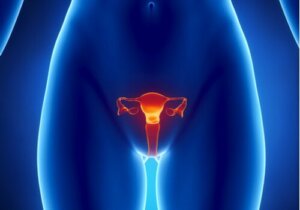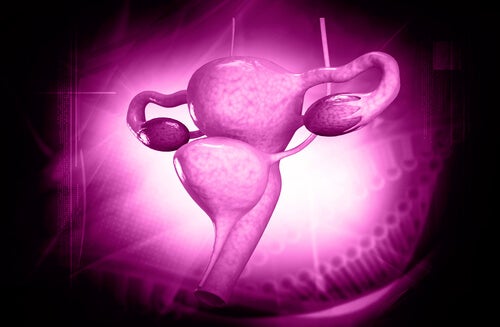The Characteristics and Functions of Different Types of Estrogens


Written and verified by the psychologist Paula Villasante
Estrogens are sex hormones that we normally associate with women. However, did you know that this hormone also takes part in both female and male reproduction? In addition, it also plays a role in other biological systems such as the neuroendocrine, vascular, skeletal, and immune systems.
Thus, estrogens are important in every individual, especially regarding the sexual and gonadal differentiation in each person. The existence of gonadal hormones in an individual, and their concentration at a given time, constitute a frame of reference which, under physiological conditions, is established by the mechanisms of sexual differentiation (1).
The precursor of estrogenic hormones is cholesterol. This forms intracellularly from acetate radicals. It can also be incorporated by cells and used in the mitochondria.
The synthesis of estrogens
As we’ve already mentioned, the precursor here is cholesterol. From the cholesterol, pregnenolone forms, and, in turn, other substances such as testosterone. This testosterone then undergoes a process of aromatization to become estrogen estradiol.

The chemical characteristics of estrogens
Estrogens can have two types of structures:
- Steroidal.
- Nonsteroidal.
Estrogens with a steroid structure
Estrogens with a steroid structure have estradiol as their main product. This sex hormone, in turn, has two metabolites: estrone and estriol. The female also produces another type of natural steroid: equilin and equilenin. In addition, there are other types of estradiol. For oral administration they’re the following:
- Valerate.
- Succinate.
In addition, there are also conjugated estrogens. These are a combination of the sodium salts of the sulfate ethers of estrone and equilin. They’re similar to those eliminated by female horses when pregnant and can be administered orally.
Estrogens with non-steroidal structure
The main ones are:
- Diethylstilbestrol.
- Chlorotrianisene. The drugs raloxifene, clomiphene, and taloxifene come from this type of estrogen.
How estrogens act on our physiology
On the reproductive system
In the reproductive system, estrogens stimulate the development of sexual characteristics in women and have a decisive influence on their reproductive cycle (1).
Thus, when puberty arrives, estrogens intervene in the development of the vagina, vulva, fallopian tubes, and uterus. Other functions of estrogens on the reproductive system are:
- They promote breast development and bone growth.
- Throughout the menstrual cycle, their cyclic variations cause changes in the genitalia, such as the secretion of vaginal mucosa.
- They act on the central nervous system. For example, the hypothalamus contains many estrogen receptors.
- When they decrease, estrogens increase the secretion of hormones such as FSH and LH. When they increase, they also directly influence the gonadotroph cells of the pituitary gland.
- They also stimulate the synthesis of progesterone receptors in the hypothalamus, which they prepare for the subsequent action of progesterone (1).

Effects on metabolism and the cardiovascular system
Estrogens cause nitrogen, salt, and water retention, which, in turn, can lead to edema formation. They also play a role in the premenopausal stage when bone mass starts to diminish.
For their part, the estrogens contained in contraceptives reduce glucose tolerance while, at the same time, increasing plasma triglycerides. However, they can also reduce bad cholesterol levels. When estrogens are used to treat conditions such as hypogonadism or menopause, they have a beneficial effect on the cardiovascular system. This is because:
- They raise good cholesterol and triglycerides.
- They lower bad cholesterol and alpha lipoprotein.
In addition, they have other effects, such as protecting our cardiovascular system and acting as an antioxidant.
Pharmacokinetic characteristics of estrogens
These hormones are absorbed through the skin, as well as through the vagina. Orally, their bioavailability is very low, so this route isn’t usually very effective.
Transcutaneously, or vaginally, they reach estradiol levels in the range of the normal follicular phase, with less elevation of estrone. Their metabolization is stimulated by inducers, such as barbiturates and rifampicin.
Adverse reactions
High doses of estrogens, such as those used in the treatment of some breast cancers, produce constant nausea. In addition, they can cause hypercalcemia if there are bone metastases.
Therapeutic applications
- Male hypogonadism.
- Children with a micropenis.
- Anemia.
- Hereditary angioneurotic edema.
- Breast carcinoma.
- Anabolic action.
- Lichen sclerosus.
Thus, estrogens are sex hormones found in the bodies of both humans and animals. They’re mainly responsible for determining certain sexual characteristics. They’re also used as medication when necessary, and, as we’ve seen, they have multiple therapeutic applications.
Estrogens are sex hormones that we normally associate with women. However, did you know that this hormone also takes part in both female and male reproduction? In addition, it also plays a role in other biological systems such as the neuroendocrine, vascular, skeletal, and immune systems.
Thus, estrogens are important in every individual, especially regarding the sexual and gonadal differentiation in each person. The existence of gonadal hormones in an individual, and their concentration at a given time, constitute a frame of reference which, under physiological conditions, is established by the mechanisms of sexual differentiation (1).
The precursor of estrogenic hormones is cholesterol. This forms intracellularly from acetate radicals. It can also be incorporated by cells and used in the mitochondria.
The synthesis of estrogens
As we’ve already mentioned, the precursor here is cholesterol. From the cholesterol, pregnenolone forms, and, in turn, other substances such as testosterone. This testosterone then undergoes a process of aromatization to become estrogen estradiol.

The chemical characteristics of estrogens
Estrogens can have two types of structures:
- Steroidal.
- Nonsteroidal.
Estrogens with a steroid structure
Estrogens with a steroid structure have estradiol as their main product. This sex hormone, in turn, has two metabolites: estrone and estriol. The female also produces another type of natural steroid: equilin and equilenin. In addition, there are other types of estradiol. For oral administration they’re the following:
- Valerate.
- Succinate.
In addition, there are also conjugated estrogens. These are a combination of the sodium salts of the sulfate ethers of estrone and equilin. They’re similar to those eliminated by female horses when pregnant and can be administered orally.
Estrogens with non-steroidal structure
The main ones are:
- Diethylstilbestrol.
- Chlorotrianisene. The drugs raloxifene, clomiphene, and taloxifene come from this type of estrogen.
How estrogens act on our physiology
On the reproductive system
In the reproductive system, estrogens stimulate the development of sexual characteristics in women and have a decisive influence on their reproductive cycle (1).
Thus, when puberty arrives, estrogens intervene in the development of the vagina, vulva, fallopian tubes, and uterus. Other functions of estrogens on the reproductive system are:
- They promote breast development and bone growth.
- Throughout the menstrual cycle, their cyclic variations cause changes in the genitalia, such as the secretion of vaginal mucosa.
- They act on the central nervous system. For example, the hypothalamus contains many estrogen receptors.
- When they decrease, estrogens increase the secretion of hormones such as FSH and LH. When they increase, they also directly influence the gonadotroph cells of the pituitary gland.
- They also stimulate the synthesis of progesterone receptors in the hypothalamus, which they prepare for the subsequent action of progesterone (1).

Effects on metabolism and the cardiovascular system
Estrogens cause nitrogen, salt, and water retention, which, in turn, can lead to edema formation. They also play a role in the premenopausal stage when bone mass starts to diminish.
For their part, the estrogens contained in contraceptives reduce glucose tolerance while, at the same time, increasing plasma triglycerides. However, they can also reduce bad cholesterol levels. When estrogens are used to treat conditions such as hypogonadism or menopause, they have a beneficial effect on the cardiovascular system. This is because:
- They raise good cholesterol and triglycerides.
- They lower bad cholesterol and alpha lipoprotein.
In addition, they have other effects, such as protecting our cardiovascular system and acting as an antioxidant.
Pharmacokinetic characteristics of estrogens
These hormones are absorbed through the skin, as well as through the vagina. Orally, their bioavailability is very low, so this route isn’t usually very effective.
Transcutaneously, or vaginally, they reach estradiol levels in the range of the normal follicular phase, with less elevation of estrone. Their metabolization is stimulated by inducers, such as barbiturates and rifampicin.
Adverse reactions
High doses of estrogens, such as those used in the treatment of some breast cancers, produce constant nausea. In addition, they can cause hypercalcemia if there are bone metastases.
Therapeutic applications
- Male hypogonadism.
- Children with a micropenis.
- Anemia.
- Hereditary angioneurotic edema.
- Breast carcinoma.
- Anabolic action.
- Lichen sclerosus.
Thus, estrogens are sex hormones found in the bodies of both humans and animals. They’re mainly responsible for determining certain sexual characteristics. They’re also used as medication when necessary, and, as we’ve seen, they have multiple therapeutic applications.
All cited sources were thoroughly reviewed by our team to ensure their quality, reliability, currency, and validity. The bibliography of this article was considered reliable and of academic or scientific accuracy.
-
Señarís, J. A. A., & Flórez, J. (2014). Hormonas sexuales: estrógenos, gestágenos, andrógenos y anticonceptivos hormonales. In Farmacología humana (pp. 803-823). Elsevier.
-
Wierman, M. E., Arlt, W., Basson, R., Davis, S. R., Miller, K. K., Murad, M. H., … & Santoro, N. (2014). Androgen therapy in women: a reappraisal: an Endocrine Society clinical practice guideline. The Journal of Clinical Endocrinology & Metabolism, 99(10), 3489-3510.
-
Jordan, V. C., & Ford, L. G. (2011). Paradoxical clinical effect of estrogen on breast cancer risk: a “new” biology of estrogen-induced apoptosis. Cancer prevention research, 4(5), 633-637.
This text is provided for informational purposes only and does not replace consultation with a professional. If in doubt, consult your specialist.







